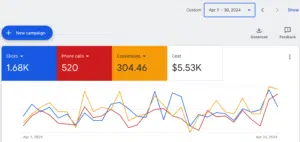Negative keywords act as a filter for your Pay-Per-Click (PPC) ads, ensuring they only appear in response to searches relevant to your products or services. This approach is all about smart advertising. Just as you choose what to show in an ad, it’s equally important to decide what not to show. By identifying and using negative keywords, you can prevent your ads from being displayed in search results that are unrelated to what you’re offering.
Table of Contents
Benefits of negative keywords
Negative keywords are super important for making sure your online ads hit the mark. Think of them like filters that keep your ads away from searches that have nothing to do with what you’re selling. Here’s why they’re a game-changer for your business:
Boosting Campaign Efficiency
Negative keywords make your ad campaigns smarter. They help your ads pop up for the right people—those who are actually interested in what you’ve got. This means your ads are more likely to get clicked by folks who want what you’re offering, making your campaign run smoother and more effectively.
Managing Your Budget Better
Using negative keywords is like putting your ad budget on a diet—it trims the fat. You stop wasting money on clicks from people who aren’t going to buy your stuff anyway. This way, you spend your budget more wisely, on ads that are shown to potential customers. It’s all about getting more bang for your buck and pushing up your return on investment (ROI).
Steering Clear of Unwanted Traffic
Nobody wants to pay for clicks that go nowhere. Negative keywords keep your ads away from searches that aren’t going to lead to sales. This cuts down on wasted money and ensures that your ad dollars are spent attracting people who are actually into what you’re selling. By keeping your ads more relevant, you’re also making sure that your website visitors are the ones you want—not just random clickers.
Why It All Matters
In the grand scheme of things, negative keywords help you understand what your audience is really looking for and how they search for it. This knowledge lets you fine-tune your campaigns over time, making them even more effective and ensuring that your ad dollars are always well spent.
Negative keywords can be categorized into three types: broad match, phrase match, and exact match. Each has its unique way of filtering out unwanted traffic, and here’s how they work:
Broad Match Negative Keywords
Think of broad match negative keywords as the wide net that catches all variations of a word or phrase. If you add “free” as a broad match negative keyword, your ad won’t show for any search that includes any form of the word “free,” like “freebie” or “freedom.” This is super handy when you want to avoid tire-kickers who aren’t looking to spend money.
Example: Adding “free” blocks searches like “free running shoes” or “running shoes for free.”
Phrase Match Negative Keywords
Phrase match is a bit more specific. It blocks your ad from showing up for searches that contain the exact phrase you’ve specified, in the order you’ve specified, but might have other words before or after it. If you’re selling new books, you don’t want your ad to pop up for someone searching for “used books,” even if they add more words to their search.
Example: Adding “used books” prevents your ad from appearing for searches like “buy used books online.”
Exact Match Negative Keywords
Exact match is like the sharpshooter of negative keywords. It targets very specific searches. If you set an exact match negative keyword, your ad will only be blocked for searches that match that exact term, without any extra words before, after, or in between. This is perfect when you want to filter out searches that you’re certain won’t convert to sales.
Example: Adding “[free yoga classes]” ensures your ad won’t show for the exact search “free yoga classes” but will still show for searches like “affordable yoga classes.”
When to Use Each Type
Use broad match when you want to cast the widest net possible to block all variations of a keyword that could waste your ad spend.
Opt for phrase match when you know the specific phrase that attracts the wrong type of traffic but still want to appear for searches that are closely related.
Go for exact matches when you’re targeting a highly specific audience and you know precisely which searches won’t help you reach your advertising goals.
Understanding how to use each type of negative keyword can help you save money, increase your campaign’s efficiency, and ensure your ads are seen by the right eyes. Just like in school, knowing which tools to use and when makes all the difference in achieving great results.
Figuring out the best negative keywords for your online ads is a bit like being a detective on the internet. You want to stop the wrong kind of traffic—people who aren’t going to buy what you’re selling—from clicking on your ads. Here’s how you can find those sneaky, unwanted keywords:
Check Your Search Term Reports
Imagine you have a secret map that shows where people started their journey before finding your ad. That’s what search term reports are. Look for words or phrases that keep popping up but don’t really match what you’re selling. If you sell high-end art supplies and see lots of clicks for “cheap art supplies,” then you know what to block.
Think Like Your Customer
Try to get inside the heads of your customers. What are they really looking for? If your product is expensive and high-quality, you might want to avoid people looking for budget options. Words like “cheap” or “free” might be good to block in this case.
Spy on the Competition
Take a peek at what your competitors are up to. If you notice certain keywords are drawing people to their sites but not really relevant to yours, those might be good negative keywords. This is a bit like looking over the fence to see what the other team is up to but in a totally fair and square way. My favorite trick is to see which keywords multiple competitors are bidding on.
Use Tools to Help You Out
There are tools online that can suggest keywords for you. These are great not just for finding the right keywords to use but also for spotting ones you don’t want anything to do with. If a keyword tool suggests something that’s off-target for your product, add it to your “no thanks” list.
Listen to What People Are Asking
Pay attention to the questions your customers ask. If you keep getting questions about things you don’t offer, those topics might be good negative keywords. It’s like knowing which roads not to take on a map because they don’t lead to where you want to go.
Keep Checking and Updating
Just like your favorite online game, the internet keeps changing, so you have to keep updating your strategy. What worked last month might not work now, so keep an eye on your reports and keep tweaking your negative keywords.
By using these tricks, you can make sure your ads show up for the right people, save money, and maybe even make your ads work better. It’s all about spending your ad budget wisely and making sure the people who see your ads are the ones who are actually interested.
Here’s a simple guide on how to do it(Google’s guide):
1. Sign in to Your Google Ads Account
Start by logging into your Google Ads account. It’s your command center for everything related to your ads.
2. Choose Your Campaign
Find the campaign or ad group where you want to add negative keywords. Click on it to dive deeper.
3. Go to Keywords
Look for a section labeled “Keywords” in your campaign menu. This is where all the magic happens with keywords, both positive and negative.
4. Find Negative Keywords Option
Inside the Keywords section, you’ll see an option for negative keywords. Click on this to start adding the keywords you don’t want your ads to show for.
5. Add Your Negative Keywords
Now, you can add your negative keywords. You can type them one by one or upload a list if you have many. Remember, these are words or phrases you want to block.
6. Choose Match Type
Decide if you want these keywords to be broad match, phrase match, or exact match. This tells Google how strictly to block searches based on these words.
Tips for Organizing Negative Keyword Lists:
Keep It Relevant: Make sure your negative keywords are relevant to the products or services you’re advertising. Irrelevant keywords won’t help much.
Use Lists: Google Ads allows you to create lists of negative keywords. This is super handy because you can apply the same list across multiple campaigns or ad groups.
Review Regularly: Your first list isn’t final. Keep an eye on your search term reports and update your negative keyword lists based on new insights.
Stay Organized: Categorize your lists by theme, product, or any way that makes sense for your business. This makes it easier to manage and update them.
By following these steps and keeping your lists organized, you’ll make your Google Ads campaigns more focused, efficient, and cost-effective. It’s all about making sure your ads reach the right audience and your budget is spent wisely.
Managing negative keywords is like being the coach of a basketball team—you need to make sure your defense is as strong as your offense to win the game. In the world of Google Ads, negative keywords help keep your defense strong by blocking unwanted traffic. Here’s how to stay on top of your game with negative keywords:
1. Regular Check-ups:
Just like a team needs regular practice, your negative keyword list needs regular reviews. Set a schedule to go through your search term reports every few weeks. Look for terms that are getting in the way of your ads reaching the right audience and add them to your negative keywords list. It’s like watching game tapes to see where your defense needs improvement.
2. Use Automation Tools:
There are tools out there that can help you find negative keywords and add them to your campaigns automatically. Think of these tools as your assistant coaches. They can save you time and make sure you don’t miss any keywords that could save you money. But remember, you’re the head coach, so review the suggestions these tools make.
3. Keep Your Lists Organized:
If you have multiple campaigns, it’s smart to organize your negative keywords into lists. This way, you can apply the same list to more than one campaign if it makes sense. It’s like having a playbook that you can use for different games.
4. Match Types Matter:
Remember, negative keywords have match types too—broad, phrase, and exact. Use them wisely to block the exact level of traffic you want. It’s like adjusting your defense strategy depending on who you’re playing against.
5. Be Specific but Not Too Narrow:
You want to block irrelevant traffic, but you don’t want to block potential customers by accident. Be specific with your negative keywords, but don’t go so narrow that you miss out on good traffic. It’s like making sure your defense is blocking the other team without getting in the way of your own players.
6. Integrate into Overall Strategy:
Negative keywords should be part of your overall Google Ads strategy. Every decision you make, from the keywords you choose to the ads you write, should work together to help you reach your goals. Think of your negative keywords as one piece of a larger puzzle that makes up your campaign strategy.
7. Learn and Adjust:
The digital world changes fast, and what works today might not work tomorrow. Keep learning and be ready to adjust your strategy, including your negative keywords. It’s like adjusting your game plan at halftime based on how the match is going.
Managing your negative keywords well is key to making sure your Google Ads campaigns are as effective and efficient as possible. It’s about making smart decisions to block irrelevant traffic, ensuring your advertising dollars are focused on attracting the right audience. By regularly reviewing your campaigns, using tools to streamline the process, and integrating negative keywords into your broader marketing strategy, you’ll enhance your campaign’s efficiency, manage your budget more effectively, and ultimately drive better results. Just like a well-coached sports team, a PPC campaign that balances offense with a strong defense—thanks to well-chosen negative keywords—is set up for success.
Ready to up your PPC game? Start by giving your campaigns a negative keyword audit. Not sure where to begin? Schedule a quick consultation with a PPC expert today or dive into our treasure trove of resources on optimizing your PPC strategy. Take the first step towards maximizing your ad spend efficiency now!






